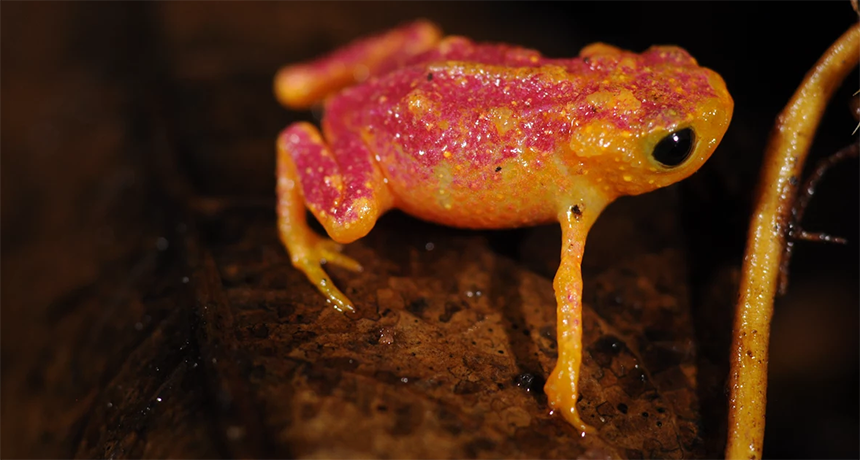Pumpkin toadlets can’t hear themselves talk
Here’s why the tiny frogs are deaf to the sound of their own voice

The pumpkin toadlet is a tiny frog that can fit on the tip of a finger. It gives off a soft, cricket-like chirp.
S. Goutte
Close to the forest floor in the mountains of Brazil, a tiny spot of neon orange makes a soft, cricket-like chirp. This male pumpkin toadlet — a frog only about the size of the tip of an adult human’s finger — is hoping to find love. But it had better not rely on its conversational skills. Both the males and females are deaf to their own calls, a new study shows. Instead, the throat swellings that accompany their chirps might be what catches a lady’s’ eye. The soft calls themselves may simply be leftovers from a long ago ancestor — and an example of evolution in action.
In many species of frogs, males grab the attention of would-be mates with a serenade. But frogs don’t have visible outer ears, as humans do. Instead, “there’s a disc behind the eye,” notes Sandra Goutte. She works at the University of Campinas in Brazil. As a herpetologist, she studies reptiles and amphibians. That disc, she notes, is the tympanum, or ear drum, of its middle ear. Sound waves hit the frog’s ear drum directly and get transmitted to the inner ear. This membrane helps to increase the amount of sound energy transmitted to the inner ear.
In that inner ear, tiny hair cells are arrayed in organized ranks. They aren’t real hairs. These just resemble them as they bend and sway in response to sound waves. Their movement transmits sound signals to the brain. In people, high frequency sounds — such as the pumpkin toadlet’s call — will bend hair cells at the base of the inner ear. Low frequency ones, such as the thud of a scientist’s foot on the forest floor, tickle hair cells farther inside.
But frogs don’t have these well-organized ears. That includes two species of pumpkin toadlet — Brachycephalus ephippium (BRAK-ee-she-faal-us Eh-FIF-ee-um) and B. pitanga. “The weird part about these frogs [is that] they don’t have a middle ear that seems to be important,” Goutte says. “But they have a call.”
The toadlets are very tiny, and so is their chirp. “This is the softest call I’ve ever heard,” Goutte says. To detect it, he says, “You need to know what you’re listening for.” Indeed, she had to strain to pick up their chirps. That led them to question whether the toadlets, which lack a middle ear, could hear their own calls.
To find out, Goutte spent two years in the laboratory and the forest working with the tiny animals. They were not always happy to have her around. “They do this angry arm-waving,” she says. “It’s supposed to be scary, but it’s not because they’re so small.”
Inner ear investigations
If pumpkin toadlets could hear their calls, Goutte and her colleagues reasoned, they should respond in some way. The males might turn toward the sounds (supposedly from their rivals) or change their own calling behavior. Females, in contrast, should walk toward the sound of their suitor’s songs.
In fact, nothing happened.
“We played their own calls in the lab or in the field,” Goutte notes. And no matter how many calls they played, the target frogs did nothing. “It never worked,” she says. “They really didn’t care. I was desperate. I wondered what I was doing wrong.”
But perhaps the frogs instead detected the sounds through their bodies. Sounds travel through the air in waves. Those vibrations might wiggle the sensitive skin of a tiny frog enough to travel through their bodies to the inner ear.
To test that, Goutte brought more pumpkin toadlets to the lab. She placed them on a vibrating plate, which she shook at the same frequency as the frogs’ calls. The frogs’ chests did vibrate. But again, the animals showed no response.

By looking carefully at the tiny ears of the pumpkin toadlets, Goutte found that the frogs weren’t just playing hard to get — they truly were hard of hearing. Their middle and inner ears were underdeveloped. These animals had no eardrums. What’s more, their inner ears had no membranes to help transmit sound. And the tiny hair cells that should sway in response to sound waves were sloppy and unorganized. While the frogs’ inner ears could respond to louder, low sounds, they never sensed the soft, high pitches of their own voices.
Even if the calls could vibrate the frog’s bodies enough to reach the inner ear, Goutte now notes, it wouldn’t matter. Without a strong inner ear to process the high, soft sounds, those calls would always go unheard. Goutte and her colleagues published their findings September 21 in the journal Scientific Reports.
“I actually think it’s a very cool and interesting study,” says Eva Ringler. She studies behavioral ecology in Austria at the University of Veterinary Medicine Vienna.
Many would have given up
Walter Wilczynski is a neuroscientist — someone who studies the brain — at Georgia State University in Atlanta. “When I first heard about [these findings] I was skeptical,” he says. After all, it’s much easier to prove that something does exist than to prove that a stimulus has no effect. “But [the team] looked at a lot of different evidence. And it’s difficult to argue with the fact that the frogs are insensitive to the frequencies of their call.”
“What makes this good science is they got a negative result, basically,” he says. “They looked at the calls and the auditory system and couldn’t find a response.” Many scientists might have given up, Wilczynski notes. Instead, Goutte’s team persisted until it found an answer. He concludes that this was “good science because it’s very thorough.”
Producing a call that you can’t even hear seems to make no sense. But the call may still serve a purpose. The toadlets inflate their bright orange throats when they chirp, Ringler notes. Frog ladies may now be on the lookout for those neon orange chin sacs. That vocal sac, she says, “is the main visual the frogs seem to need.”
This means the call itself could be vestigial — something that used to have a purpose, but doesn’t anymore. “You don’t see vestigial behaviors generally,” says Wilczynski. Vestigial body features are more common. For example, the human tailbone is thought to be one. Behaviors lacking any purpose are harder to find.
With the toadlets, the visual appeal of the throat might have replaced the sound the frogs’ ancestors once used to flirt, Goutte says. “It looks like we’re witnessing evolution in the making,” she concludes, “with one communication system taking over from another one.” As time goes on, the calls may get softer and softer. Eventually, they might fade out of the forest entirely.







